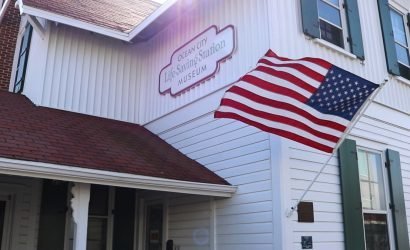 |
 |
 |
 |
Genesar: pronounced by the natives as ‘jay-nay-zee’, is a large, stately home now falling to ruin. It’s estimated that the home was built in 1732 by Major John Purnell. Throughout historical records, the home has also been known as Genezar, Genessar, Genzir, and Genezer. Today, its most commonly referred to as “that old scary house that’s collapsing in on itself and haunted by soldiers at South Point.”
Along with the stately Rackliffe house, a home of the same age less than one mile away from Genesar, the “old scary house” was used as a command spot during the Revolutionary War, the War of 1812, and the Civil War.
Accounts of traumatic events that have impacted the Genesar property have been noted in several publications:
- Along the Seaboard Side: The Architectural History of Worcester County, Maryland is a book published in 1994 by the Worcester County Library. The publication tells a story about how a British Navy ship fired upon Genesar during the War of 1812.
- The Maryland Works Project Association published an article in their guide in which it states that there were bullet holes in the structure. It’s unknown if anyone was injured by the bullets that protruded the home.
- The 3rd volume of Colonial & Historic Homes of MD claims that during the American Revolution, a British ship came through a channel carved into Assateague Island and Thomas Purnell, the original owner of Genesar, became very alarmed. He armed his servants and led them to the beach to fake a show of force towards the impeding British. By running out to the shores, Purnell secured enough time for his family to pack their possessions, bury their valuables, and flee the shores.
- According to local hearsay, a graveyard once sat in the field adjacent to the property. The graves have yet to be found and no one has proposed developing the land in which the graves are assumed to be. It could be decades before the buried bodies of old inhabitants, soldiers, and slaves are found. It’s rumored that the individuals laid to rest on this piece of land haunt the Genesar property and chase away anyone who sets foot on the property with ill intentions.
Are there still valuables buried under the soft sandy dirt on the Genesar property? Are spirits protecting their home and its buried valuables?
Currently, Genesar sits abandoned and in waiting. The structure is covered in moss and mold; a greyish green color masks the bright red brick work. A fleet of telephone poles support the aged structure and assist in keeping the building from collapsing. Piles of shingles have fallen from the single steeped roof. The interior is barren, stripped of all of its original wood, plaster, and architectural elements.
In 1966, Don and Caroline Humphrey purchased Genesar and the land surrounding. They hoped to preserve the piece of vacant and forgotten history.
“My father passed away in 2004 and dreamed of the restoration of Genesar. He also would have loved to see someone with money who could restore it…. Of his eight kids, we have not yet been able to fulfill his dream,” said Diane, a daughter of the man who previously owned the Genesar property.
Diane’s father was a local artist and a few pieces of his artwork, now worn and faded by the sun and overgrowth, can still be found hanging on the exterior walls of the historic building.
Genesar’s sister property, the Rackliffe house, has been beautifully restored recently. The Rackliffe property is currently being used as an educational facility, a representation of early 18th century architecture, and an event venue. Unlike Rackliffe, Genesar faces a bleak future. Genesar is an architectural gem just waiting for help.
Will Genesar ever been restored? Will the graves of those buried nearby ever be uncovered? Will the spirits continue to haunt the property? These questions cannot be answered now, but perhaps someday in the future.
Colored photos of Genesar were taken earlier this month by Ami Reist. Black and white photos are from the Maryland Historical Society Library. View more photos in the gallery below.








